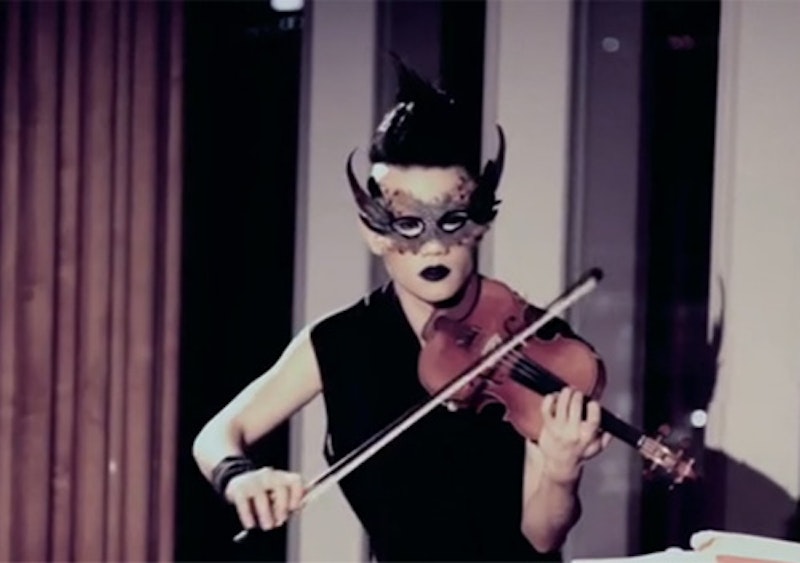For some reason I’ve been on a classical music binge, annoying my neighbors with all the waltzing around the apartment I’m doing, in high heels and cat suit no less, to the doom and gloom of Prokofiev, Rimsky-Korsakov, and Smetana. I don’t know what it is but I’m really drawn to pieces in minor keys that sound next to impossible to play—my friends say it’s because I like aggressive Russians dudes which, whatever.
The one thing about classical music that has been apparent to me for years, besides the unfortunate fact that there are absolutely zero, and I mean zero, famous black classical instrumentalists anywhere, is that this world is having a serious identity crisis. Classical music points its baton at a broader audience, the mythical younger, sexier audience by offering student tickets (wow) or showing symphonies in movie theaters where they play X–Men and Harry Potter when, despite the bait, the reality is this: go to a concert with any number of America’s Great Orchestras—the Boston and Chicago Symphonies, the New York Philharmonic, or the Philadelphia or Cleveland Orchestras—and you will see nothing but old gray hairs in tweed and vintage Chanel, fancy biscotti, and a lot of people going to sleep. At $60 a seat, that’s a very expensive nap!
The root of classical music’s identity crisis is how do you make a name for yourself with music that’s 200 years old? This is the question I wondered about the other day while at the Juilliard Bookstore browsing through their recordings (classical music albums are not called “albums,” which is reserved for lesser, more “popular” music, but the more important sounding “recordings”), and classical music’s identity crisis was laid bare to me right on the CD covers: the pianist Lang Lang in a leather jacket; the violinist Julia Fischer in a sexy low-cut top, shoulder exposed, violin way in the background; a close-up of the pianist Hélène Grimaud’s beautiful blue’s eyes; a barefoot Anne-Sophie Mutter stretched out, glamorously, on a chaise, no violin in sight. What does any of this have to do with the particular recording of Bach or Brahms being sold? Simply this: Classical music can’t stand popular music, but it wants to be the cool kid on the block so bad.
I’ve always thought that the most interesting thing about classical music recording was the number of times a piece has been performed or recorded throughout its lifetime. I mean really, just how many recordings of Beethoven’s Fifth Symphony do we need in the world? Now imagine being a soloist in this kind of environment. At least if you’re a pop singer, you’re guaranteed a brand new set of songs with each successive album, even if you didn’t write any of them, and even if they don’t sound that different from your last hits. The fact is that they are still brand new songs, and they’re yours.
If you’re a classical soloist, on the other hand, how do you make a name for yourself when every work in your repertoire has already been recorded umpteen times? I currently have three recordings of the Tchaikovsky Violin Concerto, and I like them all for different reasons. Anne Sophie Mutter has a delectable virtuosity and stinging, passionate vibrato, while Hilary Hahn has a methodical, pitch-perfect kind of sound. I have two recordings of the Prokofiev Sonata for Two Violins—one recording is lyrical and fast where it needs to be, and the other is sheer speed, aggression and virtuosity. As far as I know, classical music is one of the only worlds where people fetishize recordings and players, which leads to owning several albums with the same piece played by different people—and feeds into the music’s current identity crisis.
One way classical musicians make a name for themselves, however, is through live performance. Some violinists, like Vanessa Mae or Nadja Salerno-Sonnenberg, are known for bringing a pop music edge to classical music. Vanessa Mae performs on an electric violin and has recorded with Prince, and Nadja Saleron-Sonnenberg often records new music by composers nobody has even heard of. But Salerno-Sonnenberg in particular is known for her explosive, extremely emotional if not exaggerated performances. The cover of the recording I have of her with the Tchaikovsky Concerto is just a close-up of her face with a bunch of hair flying everywhere. Now there’s a smart—and accurate—brand image for NSS, and it tells me more about her as a performer than having some hot chick sprawled out on a chaise with her boobs out.
Hahn-Bin, classical music’s newest enfant terrible, is really the first person in decades to throw a rejuvenating wrench into the classical music machine. Trained at Juilliard in the studio of the legendary Itzhak Perlman, the interdisciplinary Hahn-Bin is one part performance artist, one part virtuoso, one part drag queen, one part mad scientist, who is as comfortable on stage in high heels as he is in a face mask—and he does it all while laying on the floor playing Penderecki. His hair piled high atop his head like a swirl of ice cream, Hahn-Bin is the self-proclaimed “Viagra to classical music.” Work! When I saw him perform at MoMA—a rarity for any classical musician—his audience was massive and diverse, very much unlike a typical classical concert. The joint was packed with people of all ages, races, nationalities, creeds, and sexualities. The future survival of classical music isn’t going to be about student tickets or sexy album covers. It’s going to be about people like Hahn-Bin.

